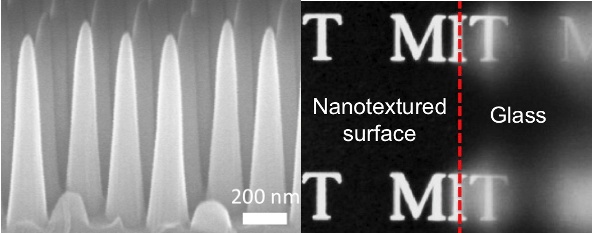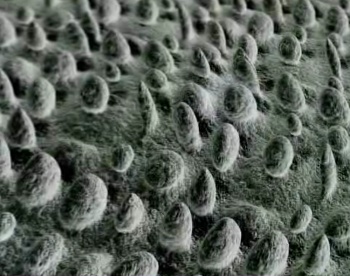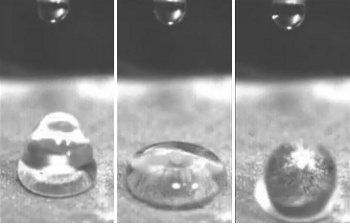Superhydrophobic Anti-Glare Glass
May 2, 2012
Glass is a versatile and inexpensive
material with many admirable
physical and
chemical properties. Although
plastic is the material of our age,[1] a cursory survey of my
pantry reveals many glass
food containers. The glass we've looked through most often is the
windshield of our
automobile, and that observation reveals some of the opportunities for improving window glass. These windows are dirty, and they produce distracting
glare.
Glass technology has had a resurgence in recent years with the strict requirements of
display glass. This started with the replacement of nearly all
cathode ray tubes, for both
entertainment displays and
computer displays, with
flat panel displays, and it continued with some special requirements for
cellphones and
tablet computers. I wrote about the glass used in the
Apple iPhone, "
Gorilla Glass," in a
previous article (Gorilla Glass, August 11, 2010). This might not be the best example, since the iPhone glass is based on some very old technology.[2]
A team of
engineers from the
Massachusetts Institute of Technology has addressed some problems with glass by a surface
microstructuring process to simultaneously reduce glare and improve surface cleanliness.[3-6] They used
conical nanotextures to give the glass surface a large
topographic roughness (see figure). When you're producing
nanoscale features covering a large
area, there are quite a few processing challenges. You need to maintain the nanoscale features of the structures and their periodicity with very few defects.
The immediate benefit of the nanostructure is that the tapered surface material presents a perfect
refractive index gradient that matches the refractive index of the glass to
air, thereby minimizing
reflection (glare). Optical transmission exceeding 98% was achieved over a wide range of
wavelengths and
incident angles, which means that the reflection was only 2%.

Left image - The surface structure of the MIT glass. The aspect ratio of the cones is about five-to-one.
Right image - The anti-fogging property of the MIT glass that results from the surface superhydrophobicity.
(MIT images by Hyungryul Choi and Kyoo-Chul Park).[3)]
The MIT team produced the microstructured surfaces using the
photolithographic and
etching techniques used in
integrated circuit fabrication. The cones were made by successive application of a
resist masking layer and subsequent etching.[3] The design of the surface was
biomimetically inspired by the surface structure of the
lotus leaf.[3]

Illustration of a lotus leaf surface.
(Still image from an animation by William Thielicke, via Wikimedia Commons)
Surprisingly, at least to me, is the idea that the surface should be
robust to the application of most
forces, including being poked with a finger.[3]
Computer simulations show that this is the case, although real
experiments are always welcome. Just as for a lotus leaf, the surface is highly
hydrophobic to an extent that it's described as
superhydrophobicity. I wrote about such hydrophobicity in a
recent article (Tiny Droplets, March 6, 2012). One of the team members,
Kyoo-Chul Park, says that
water droplets bounce off the surface "like tiny rubber balls."[5] Such a property is predicted by
Cassie's law.

A water droplet bouncing off an MIT nanostructured glass surface.
(Still images from a YouTube video.[6)]
This superhydrophobicity has quite a few advantages. The surfaces are also
anti-fogging, and they would resist
sweat contamination in
touchscreen displays.[3] There is also a self-cleaning effect, as the sessile droplets will collect dirt and roll it off the surface, a boon for my automobile windshield.[3] The greatest benefit may be in application to
photovoltaic panels.[4]
Park states that photovoltaic panels can lose 40% of their
efficiency in six
months because of dust and dirt accumulation. The MIT glass, having a higher optical transmission at even shallow angles, would allow a greater insolation of such panels, almost doubling the
harvested solar energy at certain times of the day.[3] Although the surface pattern was etched into glass, it might be possible to imprint such a texture onto plastic sheets using a heated roller.[3]
This work is described in and article in the journal,
ACS Nano, authored by
MIT mechanical engineering graduate students Kyoo-Chul Park and Hyungryul Choi,
postdoctoral associate Chih-Hao Chang, who is now at
North Carolina State University,
Robert Cohen, a professor of
chemical engineering, and mechanical engineering professors
Gareth McKinley and
George Barbastathis. This research was supported by multiple sources, notably the
Air Force Office of Scientific Research and the
Xerox Foundation.[3]
References:
- Remember, for example, this famous scene from The Graduate (1967, Mike Nichols, Director):
Mr. McGuire: I just want to say one word to you. Just one word.
Benjamin: Yes, sir.
Mr. McGuire: Are you listening?
Benjamin: Yes, I am.
Mr. McGuire: Plastics.
- David C. Boyd, "Sodium Aluminosilicate Glass Article Strengthened by a Surface Compressive Stress Layer," U.S. Patent No. 3,778,335 (December 11, 1973).
- David L. Chandler, "Through a glass, clearly - MIT researchers find a way to make glass that's anti-fogging, self-cleaning and free of glare," MIT News Office Press Release, April 26, 2012.
- Kyoo-Chul Park, Hyungryul J. Choi, Chih-Hao Chang, Robert E. Cohen, Gareth H. McKinley and George Barbastathis, "Nanotextured Silica Surfaces with Robust Super-Hydrophobicity and Omnidirectional Broadband Super-Transmissivity," ACS Nano Just Accepted Manuscript, April 8, 2012, DOI: 10.1021/nn301112t.
- Dave Smith, "MIT Researchers Invent 'Perfect Glass'," International Business Times, April 26, 2012
- Fog-free glass, MIT News Office, YouTube video, April 26, 2012.
Permanent Link to this article
Linked Keywords: Glass; material; physics; physical; chemistry; chemical; material properties; plastic; pantry; food container; windshield; automobile; glare; display; cathode ray tube; entertainment display; computer display; flat panel display; cellphone; tablet computer; Apple; iPhone; Gorilla Glass; engineer; Massachusetts Institute of Technology; microstructure; cone; conical; surface roughness; topographic roughness; nanoscale; area; refractive index; gradient; air; reflection; wavelength; incident angle; aspect ratio; superhydrophobicity; photolithography; photolithographic; microfabrication; etching; integrated circuit fabrication; resist; photomask; masking; biomimetics; lotus leaf; Wikimedia Commons; resilience; robustness; force; computer simulation; experiment; hydrophobic; superhydrophobicity; Kyoo-Chul Park; water droplet; Cassie's law; YouTube; anti-fogging; sweat; touchscreen; photovoltaic panels; energy conversion efficiency; efficiency; month; energy harvesting; solar energy; ACS Nano; MIT mechanical engineering; graduate student; postdoctoral associate; Chih-Hao Chang; North Carolina State University; Robert Cohen; chemical engineering; Gareth McKinley; George Barbastathis; Air Force Office of Scientific Research; Xerox Foundation; The Graduate (1967, Mike Nichols, Director); U.S. Patent No. 3,778,335.